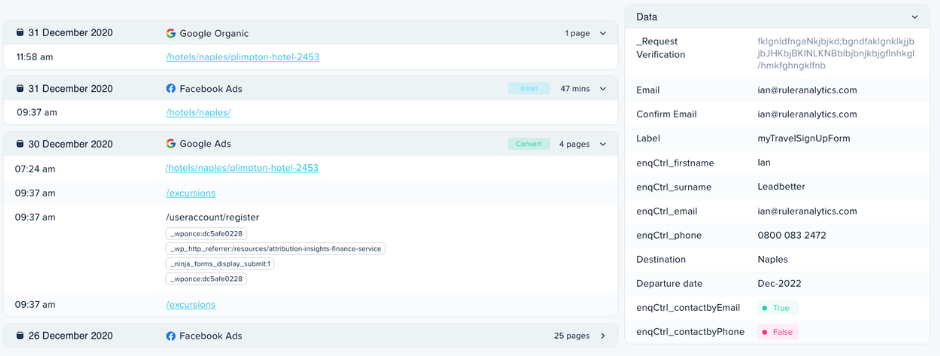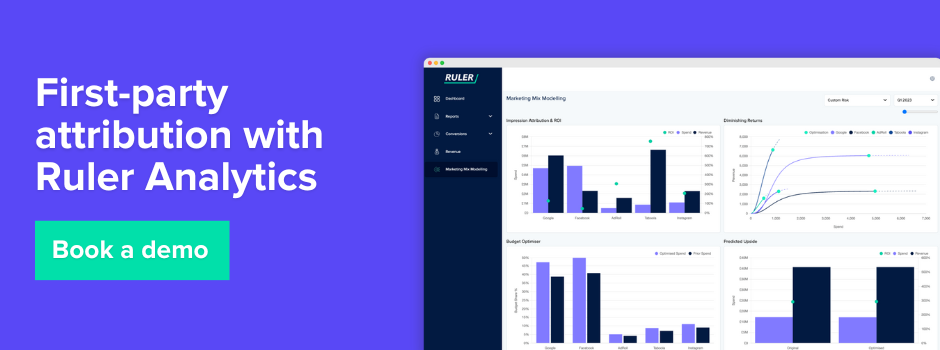With the fall of third-party cookies, marketers need to pivot and start collecting first-party data so they can continue to track and report on their performance.
Third-party cookies are becoming less effective, and marketers need to adapt.
Without them, marketers will lose crucial insights into their target audiences, such as their demographics and browsing behaviour.
First-party data is the key to success in the post-cookie era, but collecting and activating it can be challenging.
In this blog post, we’ll walk you through the steps of collecting first-party data, from developing a strategy to implementing the right tools and technologies.
Here’s what we’ll cover:
💡 TL;DR
– First-party data is information that companies collect directly from their customers, such as through website visits, purchases, and surveys.
– There are also three other types of data collection: zero-party data, second-party data and third-party data.
– Third-party cookies have been the cornerstone of online advertising for years, but have become increasingly unpopular due to concerns about privacy and security.
– Safari and Firefox have blocked third-party cookies by default, while Google has announced plans to give users more control over them, significantly reducing their reliability.
– As third-party cookies fade away, first-party data has emerged as a beacon of hope for businesses and marketers, offering a more reliable solution.
– Marketers can start tracking user data by collecting it through analytics, first-party data tracking, registration forms, surveys, and customer feedback.
Let’s start with a basic definition. First-party data is information that a company collects directly from its customers and users.
This can include:
There are also three other types of data collection: zero-party data, second-party data and third-party data. We’ve provided a table below that lists the different characteristics and variables of each data collection method, but we’ll be focusing mostly on first-party data for the rest of this blog post.
| Type of data | Collected by | Description | Consent required | Examples |
| Zero-party data | Customer provides | Zero-party data is data that customers explicitly provide to a company, such as their preferences, interests, and demographics. | Yes | Preferences, interests and demographics |
| First-party data | Company directly from its customers and users | First-party data collection is the method of directly collecting data from your own sources, meaning you own it completely. | Yes | Name, email address, purchase history and website behaviour |
| Second-party data | Company from another company | Second-party data is first-party data that is shared with another company, usually a trusted partner. | Yes | Media publishers selling data to advertisers. A store selling customer loyalty data to a credit card company. |
| Third-party data | Data aggregator from multiple sources | Third-party data is data that is collected from a company’s website or app visitors without their direct consent. | No | Cookies placed by any other site, such as an advertiser. |
First-party data is frequently used when talking about cookies and tracking data, but it basically means data created without any reliance on third parties like Google Analytics or Facebook.
Related: What are first and third-party cookies
While the use of third-party cookies diminishes, first-party data is here to stay.
Remember, first-party cookies and first-party data are not one and the same.
First-party cookies are tracking devices used to monitor and record information on your website users. First-party data includes first-party cookie data but can also include data users fill out in a form on your website for example. It’s any information that a user gives to you.
Third-party cookies have been the cornerstone of online advertising for years.
They allow marketers to track user behaviour across the web, enabling hyper-targeted advertising and personalisation.
But, this led to a number of concerns.
The most significant concern was user privacy.
Third-party cookies often track users without their explicit consent, leading to a wave of privacy regulations like GDPR and CCPA to protect people’s data rights.
Safari and Firefox have blocked third-party cookies by default, while Google has announced plans to give users more control over them, significantly reducing the reliability
This shift to a cookieless world has made it more challenging for advertisers to track users and target them with relevant ads.
In the face of these challenges, first-party data has emerged as a beacon of hope for businesses and marketers, offering a more reliable method for tracking and reaching visitors and customers.
First-party data offers:
Collecting first-party data is relatively straightforward, when you know how to do it. There are several ways you can start tracking data from your users, but we’re going to focus on the most effective methods:
Data analytics tools are an essential part of any business’s first-party data collection strategy.
They can help you track and measure a wide range of user behaviour and engagement data, including:
Once you have collected this data, you can use it to gain valuable insights into your audience, their needs, and their behaviour.
Google Analytics 4 is a great starting point for collecting first-party data and exploring consumer demographics, such as age, gender, location, industry, purchasing behaviour, and device usage.
However, it’s important to note that Google Analytics data is aggregated, meaning that it doesn’t provide individual-level insights.
On top of that, GA4 sometimes uses data sampling to make things run faster by only analysing part of your data instead of the full set.
First party data platforms can pick up everything GA4 misses. Ruler, for example, provides individual-level insights by tracking users’ touchpoints across your website and multiple channels.
Its tracking tag captures sources, UTM codes, click IDs, and logs every conversion down to an individual level like emails from forms, inbound calls, e-commerce purchases—even survey responses.

Ruler offers a major advantage by bringing together ad costs, campaign data, and even details from your CRM—like leads, opportunities, and revenue—connecting it all to every visitor’s journey on your site.
This makes it easier to see how your marketing is driving revenue, so you can make smarter decisions and fine-tune your ads for a better return on ad spend (ROAS).
Web forms can be a valuable source of first-party data, as they allow businesses to collect information directly from their visitors. These forms can be strategically designed to include fields that capture important first-party data.
For example, you can add “how did you hear about us” fields to your web forms to collect qualitative feedback from visitors, in addition to general contact details such as name, email address, and phone number.
Related: Does a ‘how did you hear about us’ field even work?
By collecting first-party data from your website forms, you can better understand your customer base and improve your marketing campaigns.
For example, if you notice that many of your leads are coming from LinkedIn Ads, you can optimise your targeting to reach other people who fit that profile.
Login and registration systems are powerful first-party data collection tools for some businesses.
When users log in or register for an account, they are typically asked to provide information such as their name, email address, shipping address, and payment information.
Not only does this provide a secure and reliable means of identifying users, but also offer a wealth of information about their preferences and behaviours.
Leveraging this data, marketers can deliver personalised experiences, enhance user engagement, and make data-driven decisions that drive growth.
Surveys are another great way to collect first-party data from your customers and website visitors. By asking questions about their demographics, interests, and preferences, you can gain a deeper understanding of your audience and what they want from your business.
Here are some tips for using surveys to collect first-party data:
Customer feedback and reviews are a valuable source of first-party data.
When customers provide feedback on your products or services, they are sharing their honest opinions and experiences.
Pay close attention to what customers are saying about your products and services. Identify common themes and trends.
You can use this information to make improvements and to develop new products and services.
First-party data is the lifeblood of successful marketing and ad targeting in the age of data privacy.
With the inconsistency of third-party cookies, marketers that have invested in first-party data collection and strategy will be well-positioned to thrive.
If you haven’t already started building your first-party data strategy, now is the time to do so.
Don’t forget. Ruler collects first-party data and tracks the individual touchpoints of your visitors and leads.
To find out more, book a demo and see how Ruler gives you a more detailed view of your customer journeys and marketing impact.
